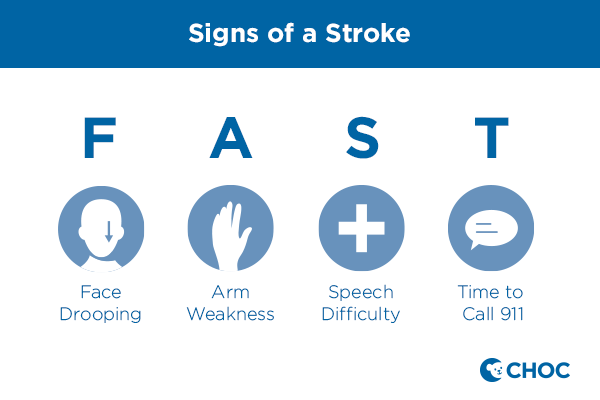Symptoms of Stroke in Children
Symptoms of strokes in children depend on the age of the child and the cause of the stroke. Below are some common signs of a stroke in infants, kids and teens.
Common Signs of a Stroke in Infants
Perinatal strokes may occur from the middle of the pregnancy, through the birth period and up until 28 days after the baby is born. In some cases, infants with perinatal stroke develop normally but at a slower pace than other kids. They also might tend to use one hand more than the other. In other cases, there are symptoms of stroke that occur during the newborn period.
Symptoms in infants and newborns could include:
- Seizures: this can manifest as repetitive involuntary jerking of the face, arm or leg, staring spells or periods in which baby stops breathing and turns blue.
- Extreme fatigue, difficulty waking up or poor feeding.
- Often there are no signs in the newborn period, but around 4-6 months old, parents or the primary care doctor may notice the baby is weaker on one side of the body, has a major hand preference before 1 year of age or is not meeting developmental milestones as expected.
Common Signs of a Stroke in Kids and Teens
Signs of stroke in children usually start suddenly. They may include:
- Weakness or loss of sensation on one side of the body or face
- Vision changes
- Inability to speak clearly or understand
- Balance problems
- Severe headache (especially with vomiting or sleepiness)
- New seizures (usually affecting one side of the body)
If your child has symptoms of a stroke, call 9-1-1 or your local emergency number.
How to Remember Signs of a Stroke
F.A.S.T. is an easy way to remember the signs of a stroke. If you spot any of the signs,
call 9-1-1 immediately.
 F.A.S.T.
F.A.S.T. stands for:
- F is for face drooping – One side of the face is drooping or numb. When the person smiles, the smile is uneven.
- A is for arm weakness – One arm is weak or numb. When the person lifts both arms at the same time, one arm may drift downward.
- S is for speech difficulty – You may notice slurred speech or difficulty speaking. The person can’t repeat a simple sentence correctly when asked.
- T is for time to call 9-1-1 – If someone shows any of these symptoms, even if they go away, call 9-1-1 immediately. Make note of the time the symptoms first appeared.
 F.A.S.T. stands for:
F.A.S.T. stands for:












